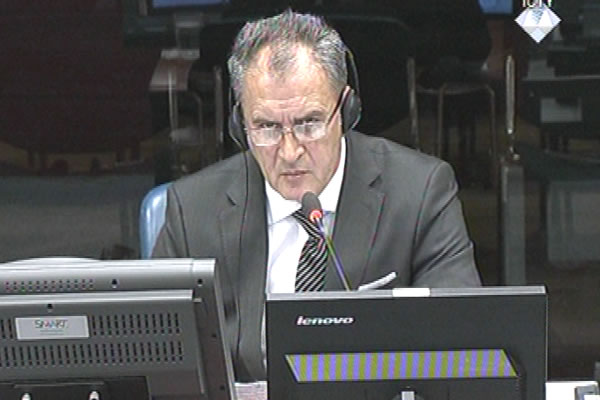Home
‘PLAGIARISM’ IN MLADIC’S EXPERT REPORT
Mitar Kovac, a general with a military and academic background, was forced today to defend himself against allegations of plagiarism. Kovac was asked by Ratko Mladic’s defense to write an expert report. Before Kovac took the stand, the defense called former VRS soldier Dragan Vujcic. He said he didn’t know who had buried the bodies in the Tomasica mass grave near Prijedor, although he was able to say who had not done it
 Mitar Kovac, defence witness at Rako Mladic trial
Mitar Kovac, defence witness at Rako Mladic trial When he appeared in court last week, retired general Mitar Kovac introduced himself as an experienced soldier, with a solid background in military matters and in the academic domain. Kovac, who was called by Ratko Mladic's defense as an expert witness, stressed that he was awarded the prestigious Transfer of Wisdom award at a book fair in Nis for one of his books. Today in the cross-examination the prosecutor noted that the witness ‘transferred wisdom’ from other sources to his expert report. Since the witness failed to identify his source in the footnotes, his actions amounted to plagiarism, the prosecutor said.
In the report he wrote at the request of Ratko Mladic’s defense, Kovac copied 'almost in full’ an article from Wikipedia on the death of Bosko Brkic and Admira Ismic. The two young people, a Serb and a Muslim, were killed in Sarajevo. Kovac failed to quote the source he had used, the prosecutor said. Kovac agreed that he may have taken the text from Wikipedia as the ‘basis for the quote’, but he was adamant that the actual reference is to an article in the newspaper Slobodna Dalmacija even though the words he quoted are not in there at all.
Furthermore, yesterday the prosecutor identified 54 paragraphs in Kovac's report which had been largely copied from reports drafted by General Radovan Radinovic. Radinovic appeared as a witness at several trials before the Tribunal. When he looked at the report the witness admitted that in those paragraphs he copied 10 to 90 per cent of Radinovic’s text verbatim, or about 65 per cent on the average. Kovac also admitted he had failed to identify the sources in 36 paragraphs; in fact, he presented the other expert’s findings as his own. When he talked specifically about one example, Kovac initially claimed that he had copied 70 or 80 per cent of Radinovic’s text, but was forced to admit that in fact he had copied 100 per cent of Radinovic’s text without identifying the source.
This prompted the prosecutor to ask Kovac what he would tell the students he taught at several faculties in Belgrade if they tried to pull off something similar. Professor Kovac replied that he would ‘draw their attention to take that into consideration’. Using other author's text without identifying the source, was not 'such a big deal' in Kovac's view. ‘Does that mean that plagiarism isn’t a serious violation of professional ethic’, Judge Moloto asked. The witness replied that Radinovic’s words made up only three per cent of his work. According to Kovac, it really did not matter that much.
Explaining why he relied on Radinovic's findings in his report, the witness said that for a while Radinovic was his superior in the army. Kovac 'looked up' at Radinovic. This statement prompted prosecutor Weber to quote Radinovic’s public statements. Radinovic called Seselj a ‘metaphor of Serbian nationalism and identity’, spoke in favor of transferring population and advocated a ‘new Serb state’ to ‘control’ the border on the Drina. Kovac said he did not quite agree with what Radinovic had said about Seselj. All three ethnic communities in BH did move into the territories under the control of their ethnic armies, Kovac insisted.
In Kovac’s opinion, the transfer of population and the crimes were natural consequences of a ‘typical civil war’, which was waged in BH. The witness was then confronted with several documents showing that Mladic’s army expelled non-Serb civilians from the part of BH claimed by the Serbs. The witness was adamant that it happened ‘on all three sides’.
General Kovac will continue his evidence tomorrow. This morning, before Kovac took the stand, the defense called Dragan Vujcic, who testified via video link from Banja Luka. Vujcic was in the Engineering Battalion of the JNA 343rd Brigade. The unit later became the VRS 43rd Brigade. In his statement to the defense, Vujcic said that his unit did not bury the bodies of non-Serb civilians from Prijedor in the Tomasica mine in June and July 1992. The Tomasica mine was a part of the Ljubija mine complex. As the witness said, at that time his battalion, as well as most of the 43rd Brigade, was deployed far from Prijedor. Vujcic didn’t deny the possibility that some other unit in the Bosnian Serb army had buried the bodies.
Linked Reports
- Case : Mladic
- 2015-11-17 EXPLOITING ISLAMOPHOBIA IN TRIBUNAL’S COURTROOM
- 2015-11-16 ‘TYPICAL CIVIL WAR’ IN BH
- 2015-11-12 OBSTRUCTING ‘NON-EXISTENT’ TRIBUNAL IN THE HAGUE
- 2015-11-19 SARAJEVO CIVILIANS LACKED ‘SAFETY CULTURE’
- 2015-11-23 'QUANTUM DIFFERENCE' IN CRIMES
- 2015-11-24 AKASHI'S 'THINKING OUT LOUD' ABOUT MLADIC
